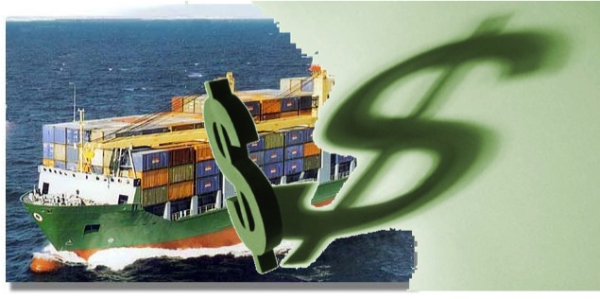What’s Actually Happening with Freight Rates Right Now
In the last blog, we looked at how – with the slowing economy – retailers and shippers are decreasing their imports and expected to keep doing so in 2023. As discussed, that should mean decreasing freight rates, but there are a few factors that could stop them from falling. Today, instead of projecting, let’s look at what is actually happening with freight rates right now.
General Downward Trend
I’ve mentioned in a number of recent blogs that freight rates have finally started coming down a bit. Unfortunately, there hasn’t been a big, sudden drop. Rather, freight rates have simply been trending downward in recent months.
Ocean freight rates for container shipping are no longer more than 500% higher than they were pre-pandemic. I remember vividly, in October of 2021 first having to painfully write that freight rates were more than five times what they were before the pandemic hit. The way freight rates had skyrocketed was downright scary – appropriate for the month of Halloween.
Frankly, freight rates are still incredibly high. They’re still multiple times higher than pre-pandemic freight rates. But at least they’ve been moving in the right direction and are now significantly lower than when freight rates were at their peak.
Downward Trend Plateaued, But Don’t Worry
While freight rates have been trending down, here in the last month or so, container shipping rates have leveled off. In fact, some even just went back up a bit. However, we’re in international shipping’s peak season, and port congestion is still a problem. Peak season’s demand typically increases freight rate as does port congestion by limiting capacity.
Therefore, shippers shouldn’t panic, thinking the decline in freight rates is over and now we’re going to watch them skyrocket higher and higher again.
Why No Big Drop in Freight Rates?
Of course, what shippers keep hoping to see is a big drop in container freight rates. And why not? The dry bulk shipping sector seems to have gotten one.
For an MSN article on Sunday (August 7th), Anish Mondal even used the phrase “freight falls steeply” in the headline. Mondal reports:

The Baltic Dry index, which provides a benchmark for sea freight of moving major raw materials stood at 1,560 points on Friday, its lowest point since February as demand remained weak across all vessel categories amid the uncertainty around global economic growth. The index, which takes into account 23 different shipping routes, has declined by 23% in [the] last one month and 53% in a year.
If dry bulk shipping can steeply fall, why not container shipping?
As if in response to this very question, Greg Miller wrote the following in an excellent American Shipper article, published Monday (August 8th), about freight rates:
There’s an old Greek shipping saying that goes: “Ninety-eight tankers and 101 cargoes, boom. Ninety-eight cargoes and 101 tankers, bust.” This doesn’t translate so well into modern-day container shipping because the consolidated liner sector manages the number of ships in service a lot better than the fragmented tanker business.
Tanker spot rates can plunge violently lower when supply exceeds demand. One of the big questions for container shipping has been: Will spot rates plunge precipitously after demand pulls back, as it has in the past in bulk commodity shipping? Or will there be a gradual decline toward a soft landing?
So far, it looks gradual. Trans-Pacific rates have steadied in July and early August. In fact, some indexes show spot rates ticking higher again.
Spot rates are at least temporarily plateauing because U.S. import demand remains above pre-COVID levels, some U.S. ports remain extremely congested, and ocean carriers are “blanking” or “voiding” (i.e., canceling) sailings, both because their ships are stuck in port queues and because they’re matching vessel supply with cargo demand to avert the fate of Greek tanker owners.
Carriers blanking sailings was one of the factors I talked about in the last blog that can stop freight rates from dropping. Since all the major ocean freight shipping lines banded together into carrier alliances, they’ve really been able coordinate and control the amount capacity in shipping lanes. They blank sailings, avoid demand falling below supply, and keep freight rates from tumbling.
Back when carriers struggled with overcapacity, carriers dealt with losses in the billions of dollars. Now, their profits are in the billions of dollars. And shippers pay more to import and export.
Freight Rate Data
One of the nice things about Miller’s article is it contains data from different freight rate indices together in one place. There’s variation between indices as they gather their data differently. The biggest difference often has to do with whether they use base level freight rates or include various fees carriers add to those rates. The more of these rate indices you look at, the easier it is to see the trends in freight rates.
Miller often shares this kind of data in his articles and even gives some analysis by comparing current freight rates to previous ones, as he does here:
The Freightos Baltic Daily Index (FBX) Asia-West Coast assessment was at $6,692 per forty-foot equivalent unit on Friday.
The good news for shippers booking spot cargo: That’s just one-third of the all-time peak this index reached in September. The bad news: Friday’s assessment is up 2.7% from the low of $6,519 per FEU hit on Aug. 2, and it’s still 4.5 times higher than the rate at this time of year in 2019, pre-COVID.
The FBX Asia-East Coast spot rate assessment was at $9,978 per FEU on Friday, less than half the record high in September. However, it was up 3.5% from the recent low of $9,640 on Aug. 2 and still 3.6 times higher than 2019 levels.
The weekly index from Drewry portrays a gentler descent than the FBX, because Drewry did not include premium charges in its spot assessments at the peak.
Unlike the FBX, Drewry’s Shanghai-Los Angeles assessment does not show a recent uptick. It was at $6,985 per FEU for the week announced last Thursday, its lowest point since June 2021. It was down 44% from its all-time high in late November 2021, albeit still 4.2 times higher than rates at this time of year in 2019.
Drewry’s weekly Shanghai-New York assessment was at $9,774 per FEU on Friday. Rates were relatively stable over the past two week, yet the latest reading is the lowest since June 2021 and down 40% from the peak in mid-September.
Drewry’s Shanghai-New York assessment on this route is still 3.5 times pre-COVID levels.
Gap Growing Between East Coast & West Coast Rates
Shipping from Asia to the East Coast is always more expensive than Asia to the West Coast, but the cost gap is growing.
We’ve touched on East and Gulf Coast port congestion a number of times lately in Universal Cargo’s blog. It has gotten pretty severe. East and Gulf Coast ports have seen significant influxes in cargo as shippers have diverted cargo there from West Coast ports for a couple of reasons.
Severity of congestion that has been seen for so long at West Coast ports is one of the reason shippers moved entry points. Uncertainty over the International Longshore & Warehouse Union (ILWU) contract negotiations is another. Now there is also the issue of truckers in California demonstrating and striking over Assembly Bill 5 that increases risk of disruption at ports like those of Los Angeles, Long Beach, and Oakland.
As previously stated, port congestion tends to limit capacity and increase freight rates. Just yesterday, Teri Errico Griffis reported in the Journal of Commerce on Hapag-Lloyd and Maersk extending restrictions on a joint service to the East Coast because of the congestion there.
Here’s the data on the rate gap Miller shares in his article:
Daily assessments from S&P Global Commodities (formerly Platts) show a widening divergence between North Asia-West Coast and North Asia-East Coast Freight All Kinds (FAK) rates.
S&P Global assessed Friday’s North Asia-East Coast FAK rate at $9,750 per FEU, up 2.6% from the recent low hit on July 29. Spot rates on this route have roughly plateaued since late April, according to this index.
S&P Global put Friday’s North Asia-West Coast rate at $6,500 per FEU, still gradually falling and at the lowest point since late June 2021. The gap with East Coast assessments has been widening since May, with the East Coast rates now 50% higher than West Coast rates.
Conclusion
Freight rates are slowly coming down and experts expect them to continue to do so. But gradually. Between the current port congestion and peak season, there won’t likely be much freight rate decline at the moment. There may even be some increases similar to those seen last week.
Labor strife from the ILWU during the current contract negotiations, the risk of rail stoppage or slowdown (discussed in previous posts), and carrier alliances’ control of capacity could significantly hinder freight rates from dropping. In fact, these factors even have the potential of pushing rates up.




